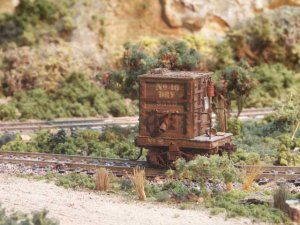Left Behind
- Thread starter Casey Feedwater
- Start date
You are using an out of date browser. It may not display this or other websites correctly.
You should upgrade or use an alternative browser.
You should upgrade or use an alternative browser.
That's some really neat modeling, love the car and the ground cover is excellent!!! Photo's not bad either.


OK, so, would you call that a "truck-load" of sand?? Neat little car, I'm almost afraid to ask what the caboose looks like.
Pete
Pete
The caboose is yet to be built. But it will have lots of that backwoodsie, home-built charm to it. Just like the rest of 'em. 
OK, so, would you call that a "truck-load" of sand?? Neat little car, I'm almost afraid to ask what the caboose looks like.
Pete
Pete
Now there's an idea, Shamus. Interchange or interline loan/lease of rolling stock.
The only problem is, the Badger Creek is in the Northwest, while the OVT&L is in the Midwest. That would be a hell of a long way to go to make transfer.
Casey both the water and the sand cars are really interesting. Forgive my ignorence but how are the used.
t.
t.
t., water cars were quite common in "back woods" operations, particularly in very remote areas, and they were used for a variety of purposes. Among other things, they were used to put out small fires along the right of way, to feed steam donkeys (especially in remote areas), to refill the canvas water bags on mules and horses (these were used in turn to fill the water buckets along skid roads), and to sprinkle the area around landings and transfer points to reduce fire danger. Most water cars ranged from 350-1000 gallons each. They typically had a pump to draw water from creeks, as well as to spray or sprinkle water under pressure.
Likewise, sand cars had a number of uses. Because logging trackage was often rough and crudely constructed on steep grades, piles of sand could be strategically dropped along the right of way and then hand shoveled on the rails for additional traction. They were also used to help smother "hot spots" after small fires had been put out. I have also read about- but never seen any photos of - sand being used in the logging areas to clean the carbon out of the flues of lokies and steam donkeys/yarders/etc. (Apparently, sand was placed in the fireboxes while the drafts were wide open. This drew the sand through the flues and cleaned out the carbon. Looking at the way most logging roads maintained their equipment, I can't imagine most were that concerned about cleaning, though!)
Likewise, sand cars had a number of uses. Because logging trackage was often rough and crudely constructed on steep grades, piles of sand could be strategically dropped along the right of way and then hand shoveled on the rails for additional traction. They were also used to help smother "hot spots" after small fires had been put out. I have also read about- but never seen any photos of - sand being used in the logging areas to clean the carbon out of the flues of lokies and steam donkeys/yarders/etc. (Apparently, sand was placed in the fireboxes while the drafts were wide open. This drew the sand through the flues and cleaned out the carbon. Looking at the way most logging roads maintained their equipment, I can't imagine most were that concerned about cleaning, though!)
Thanks Casey for the info. As my new layout will be centered around a branch line rock quarrying road I might could use something like that. I think I'll name them frick and frack. 
t.
t.



